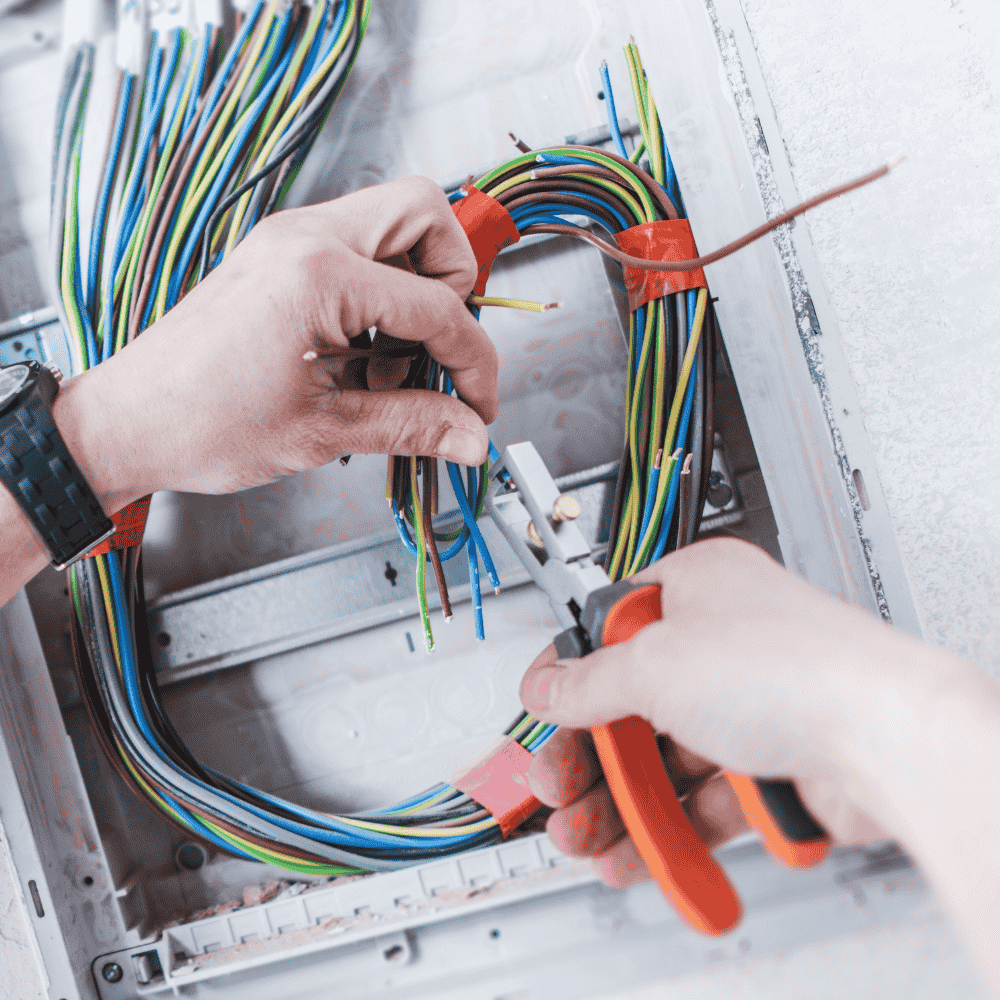Cold Weather Exposes Weak Electrical Systems
Heaters hum to life, electric blankets get plugged in, and everyone suddenly remembers that their coffee maker has a “keep warm” feature.
Cold weather doesn’t just bring frosty mornings and holiday lights—it shines a spotlight on the weakest parts of residential electrical systems. As temperatures drop, homes draw more power. Heaters hum to life, electric blankets get plugged in, and everyone suddenly remembers that their coffee maker has a “keep warm” feature. With that surge in usage, hidden electrical flaws rise to the surface like steam on a frozen driveway.
Winter Puts Pressure On The System
Winter demands more from every circuit. Space heaters, furnace blowers, holiday lighting, and increased indoor activity all mean that outlets, breakers, and wiring carry a heavier load. What worked fine in the mild months may buckle under winter’s pressure. Weak connections, outdated panels, and damaged wiring often don’t reveal themselves until they’re overwhelmed.
A small issue in October can turn into a tripped breaker in December—or worse, a fire hazard. Electrical systems reveal their weak spots when demand spikes. The wiring behind the wall, which is slightly frayed, the panel overloaded by a hot tub installation years ago, and the outlets that spark when a plug is inserted—winter doesn’t create those issues; it simply exposes them.
Signs Of Stress Start Subtly
The earliest signs of electrical strain are often overlooked or dismissed as quirks. Lights that dim slightly when appliances start up. Warm wall plates. Buzzing outlets. Occasional breaker trips. These are warning signs, not personality traits. Cold weather amplifies every flaw, and without proper attention, those subtle hints grow louder.
People often work around electrical issues instead of addressing them. An overloaded outlet becomes home to a power strip or two. The garage freezer shares a circuit with a treadmill. Eventually, something gives. Winter doesn’t leave much room for error. Electrical systems must meet demand without resorting to improvisation.
The Silent Struggle Behind The Walls
Wiring ages. Connections corrode. Breaker panels fill up. Homes evolve, but the original electrical system often doesn’t keep pace. Additions, remodels, and modern appliances place new demands on circuits that may have been designed decades ago. The system can only stretch so far before it starts to crack.
Cold weather introduces more variables—metal contracts, which can loosen electrical connections. Moisture from snow and freezing rain can sneak into poorly sealed outdoor outlets or boxes. Rodents seeking warmth might chew through insulation in attics and basements. All of these factors conspire to stress an already burdened system.
Professional Electrical Services Keep Homes Safer
Trained electricians approach winter prep with precision. They know where systems tend to fail and what signs point to deeper problems. A comprehensive inspection can identify overloaded circuits, outdated panels, improper grounding, and worn insulation before they create emergencies. Repairs made proactively during the cooler months prevent chaos when the system reaches peak load.
Routine upgrades, such as installing AFCI and GFCI protection, improve both safety and performance. Replacing aging outlets or rewiring key circuits supports increased seasonal demand without overloading the system. Electricians also verify grounding and bonding, which become even more critical when heating systems, generators, or backup power sources are added to the mix.
Heat Demands Highlight Circuit Flaws
When every room relies on heat, the power demand becomes relentless. Electric baseboard heaters, radiant floor systems, and even heated towel racks draw steady current for hours at a time. Homes that once relied on central gas heat often supplement with plug-in electric heaters. Those devices strain circuits, especially older ones, never designed to carry constant high loads.
Flickering lights, frequent breaker trips, or the need to unplug one appliance before using another all indicate that the system isn’t keeping up. Professional service addresses these concerns by adding dedicated circuits, upgrading wiring, or balancing the load across multiple breakers. These aren’t just upgrades—they’re investments in safety and comfort.
Outdoor Electrical Components Feel The Freeze
Exterior outlets, light fixtures, and wiring take a beating during the winter months. Cold temperatures, wind, ice, and moisture test the integrity of seals, covers, and weatherproofing. A cracked outlet box or missing gasket might not seem serious until melting snow reaches live wiring.
Poorly protected exterior systems also pose a risk of short circuits and fire hazards. Seasonal lighting adds another layer of stress. Extension cords exposed to ice and snow wear down quickly. Timers, adapters, and splitters amplify the strain. A licensed electrician helps prevent these problems by verifying outdoor installations meet current safety standards and are protected from the elements.
Standby Power And Backup Readiness
Cold snaps come with power outages. Whether it’s due to heavy snow, ice storms, or increased grid demand, many homes experience power outages during winter. That’s when backup systems, such as generators and battery storage, become essential. However, even those systems require a safe and efficient electrical foundation to operate correctly.
Connecting a generator directly to a home’s wiring demands professional installation. Transfer switches, load calculations, and grounding all play a part. When installed incorrectly, backup power creates risk for both homeowners and utility workers. A professionally installed backup system functions seamlessly and safely when it’s needed most.
Home Automation And Winter Loads
Smart thermostats, Wi-Fi-enabled heaters, security systems, and lighting controls help manage energy use, but they also depend on a reliable electrical network. If the system behind the tech can’t handle the load, smart devices lose their usefulness. Constant reboots, dropped connections, or inconsistent power affects performance.
Upgraded electrical panels and clean, consistent wiring create a strong foundation for home automation. Electricians familiar with integrated systems make recommendations that support today’s connected homes without overloading yesterday’s circuits. That preparation pays off during long winter nights when comfort and convenience matter most.
Staying Ahead Of Seasonal Surprises
Electrical systems don’t fail all at once. They show signs along the way—signs that grow more obvious as temperatures drop. With colder weather on the horizon, preparation becomes the key to the difference between comfort and crisis. Professional electrical services help identify weak spots, make timely upgrades, and provide comfort that the system will perform reliably, regardless of the temperature.
When the cold sets in, the house leans on its electrical backbone. Every appliance, outlet, and light fixture plays a part. If one link weakens, the chain starts to strain. Taking care of those systems before they fail keeps homes safer, warmer, and far more enjoyable throughout the coldest months of the year.
Cold weather may expose weak electrical systems, but proactive care turns vulnerability into strength. A well-maintained system handles winter without flinching—quiet, strong, and ready for whatever the season brings.

